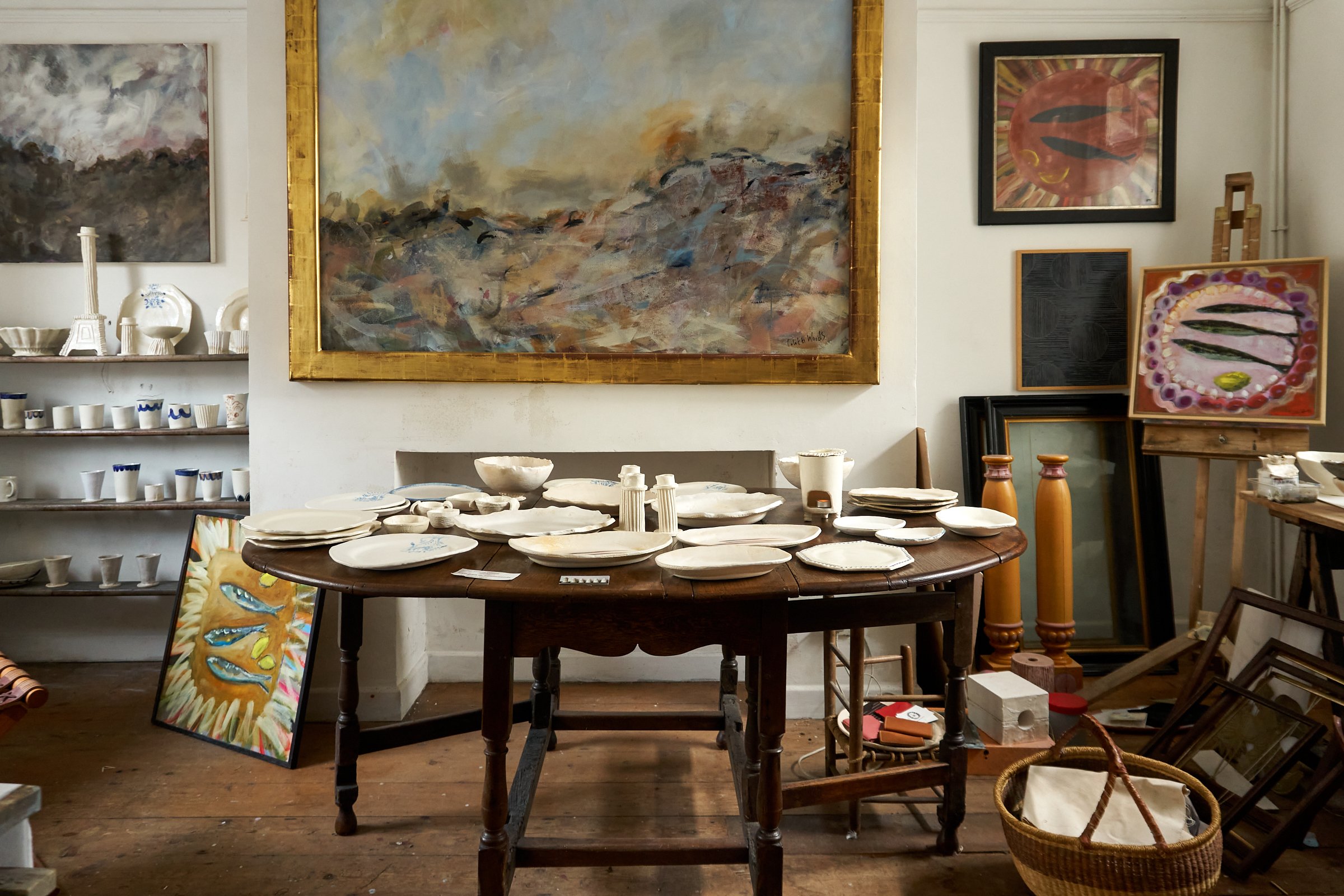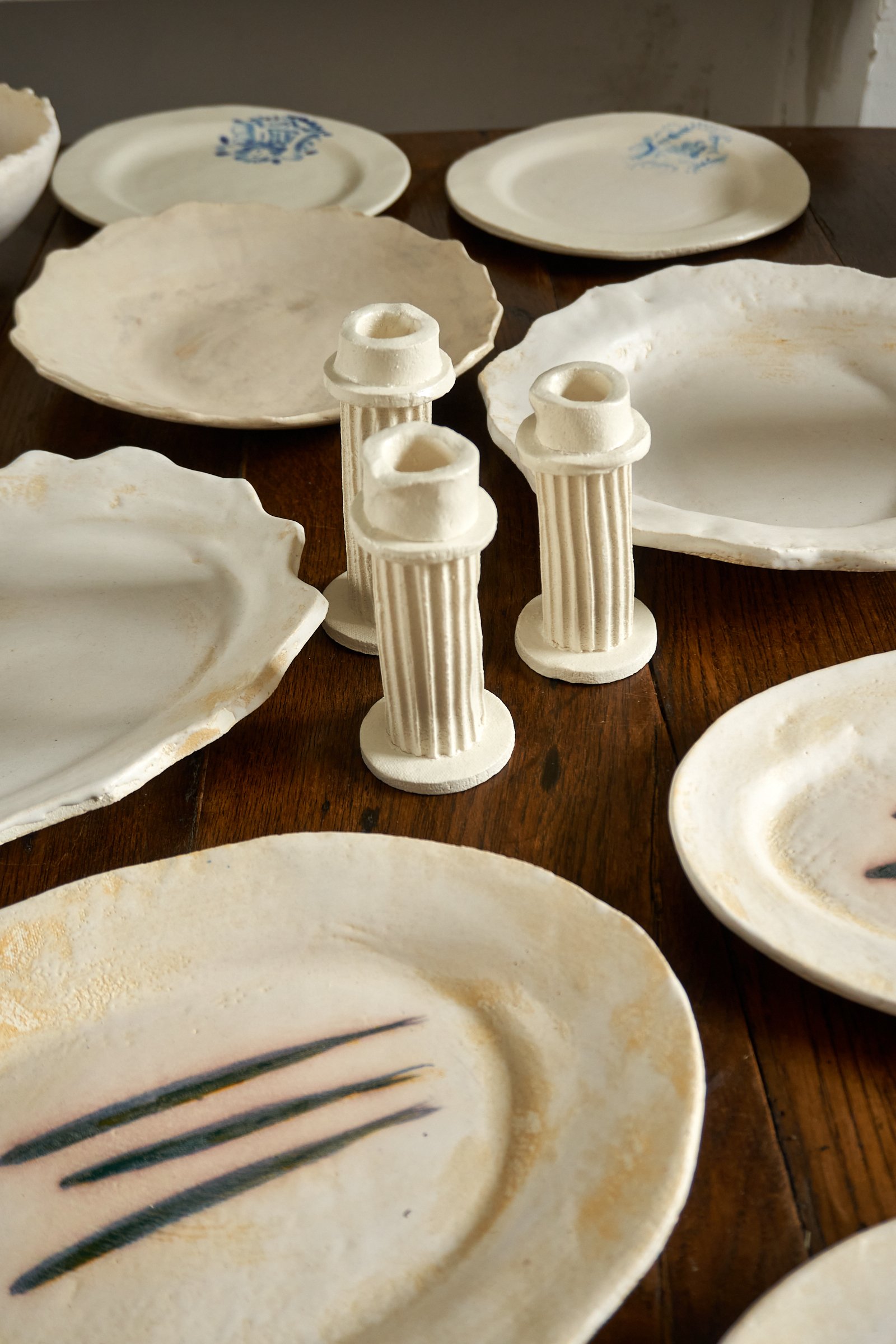Artist Colette Woods for The World of Interiors
PERFECT IMPERFECTIONS
For five years, Colette Woods has been showing her paintings and wonderfully wonky ceramics in her home/studio in Bruton, Somerset, as well as online. But now, with a desire to focus on creating fine-art pieces, she tells us about the thrill of shutting up shop in favour of staging regular pop-up events and private views
The small town of Bruton in Somerset is well known for its magnetism, drawing visitors both to stay and to house-hunt. A pocket of creativity, the area around it is known for its smart galleries, stylish restaurants and thriving designer/maker community; Hauser & Wirth is a short stroll away and independent shops such as Rag of Colts and Philo & Philo are among the most fashionable in the country.
Nestled at the lower end of Bruton is the home/studio of artist and ceramicist Colette Woods, which is also a shop window for her work. Oil paintings of landscapes and platters of fish are propped on easels. Shelves and surfaces are covered with highly sophisticated unrefined stoneware mugs, bowls, vases and candlesticks, whose gloriously imperfect forms and hand-painted creamy glazes are begging to be held. Her creations tread the line between function and fine art – mostly functional now, but in the future, she plans to tip the balance to fine art.
Colette’s beautiful dinnerware and vessels are made of stoneware, a strong clay fired to a higher temperature than earthenware, so it’s more durable. She mixes many of her own glazes, with splashes of colour made from cobalt oxide making an appearance as swags. Photograph Claire Bingham
‘I’m allowing the process to guide me,’ explains Colette of her intentions to produce more sculptural objects that have no practical function other than decoration. ‘I’m not a production ceramicist. I’m an artist who makes ceramics. I think there is a difference. I’m continually challenging myself and forever inspired by new things, which in turn informs what I make. I’d like to make larger ceramics, which people seem to love, alongside my functional practice.’
Since the early 2020s, Colette has given up her living room to accommodate a painting studio and a place where her works can be displayed and sold. Since that time, she has gained a cult following on Instagram, where she sells many of her pieces via direct message. Currently her art is included in an exhibition, À Table!, at jewellery designer Sophie Breitmeyer’s boutique in Notting Hill and her dinnerware is part of the place settings at local Michelin-cheffed restaurant Osip.
Above the dish-stocked trestle table is a large Somerset landscape in a vintage gilt frame. Colette often goes to Batcombe for preliminary sketching as it’s open and the sky is vast
Faces, be they animal or human, often appear in Colette’s work. Inspired by her love of Italian and French art, the blue woman is ‘Hortense’ – she likes to christen her imagined characters with old French names
‘I open my painting studio every Saturday and Sunday,’ says Colette of this gem of a creative space. In the alcove is a selection of her scalloped, fluted and deliberately dented glazed stoneware. Each piece is individual, from the moulding to the various glaze effects. It’s tricky to pinpoint a favourite. There is a liveliness in everything – painting or pot – yet the palettes of subtle shades are so pretty.
She favours the slower process of hand construction (whether it’s coiling, slab building or pinch moulding) to throwing – ‘They’re nice but they don’t excite me the same as a hand-built piece’ – and her visual aesthetic veers towards imperfection. She says: ‘I find beauty in the abstraction of perfection. There is so much beauty in nature I almost don’t want to replicate it in any way.’
Her work has evolved over the past few years: female faces have been introduced into non-figurative motifs. The subjects of her paintings seep into her ceramics. Sometimes it is the other way round. The skill for Colette as an artist is knowing when to stop. ‘It’s so easy to overdo a work,’ she says. ‘You need discipline. Also, it comes with doing anything for a long time; you get a feel. Like with cooking, after many years of making one recipe, you don’t measure the ingredients, you eyeball it instead.’
Colette works from a kiln studio a few villages away – a converted shipping container in an old cow shed on a farm
Colette studied Surface Design for her college degree but over the past ten years has found a joy and freedom in forging a career in painting and clay. ‘With my work, I’m exactly where I want to be,’ explains Colette. ‘I don’t have that hunger nor desire to get on in the world of commerce. It’s about slow living and enjoying each day in what I do’
One technique Colette likes to employ is taking photographs of her forms mid-process, so that if she makes a mistake, she can go back to see where she feels she went wrong. ‘It’s a useful trick I’ve taught myself over the years. Clay is different to painting. It has a memory. It’s magical, really. If you make a dent in a plate, it’s hard to take that dent away even if you can’t see it. When you put it in the kiln, the heat process brings back the memory and will warp the clay to try to get back to the dent.’
The kiln has its own alchemy, and taking out the fired pieces is a ritual Colette finds particularly lovely. ‘Each time I open the kiln it’s like Christmas. I never know what I’m going to find. There are so many things that happen in the high temperatures that can destroy your work in 24 hours. Each glaze reacts differently. It might drip, it might run. It could crack, it could bubble. I look at everything; I turn it and see what I’ve enjoyed about making that piece and the outcome. It’s like a gift.’
On and against the easel are two mixed-media landscapes, inspired by nearby Batcombe in Somerset
Next year’s plans will see the shop open only for pop-ups and appointments, so Colette won’t be tied to being there at weekends. ‘This will give me freedom,’ she explains. ‘I’ll be able to work at my kiln studio and paint at home more often. I don’t mind painting when people come in, but the outcome is usually quite different to painting in a solitary environment. The punctuations are lovely – visitors are interested in what I’m doing – but at the same time it stops my thought patterns. With the closing, I’ll be able to do a lot more painting without interruption, which will be nice. Plus, I think change is healthy for any creative person.’
No longer will she have to switch between shopkeeping and productivity, and she can just stay in that inventive frame of mind. ‘I’m going to trial it and see what works,’ she says. ‘Bruton can be quiet down this end.’ However, tides shift. With a chocolate shop due to open on the opposite side of the street, who wouldn’t want to shop at Colette’s with a cup of cocoa in hand? After all, you can never have enough mugs. Drinking from a beautiful vessel is one of life’s very particular joys.
For more information, visit colettewoods.com







